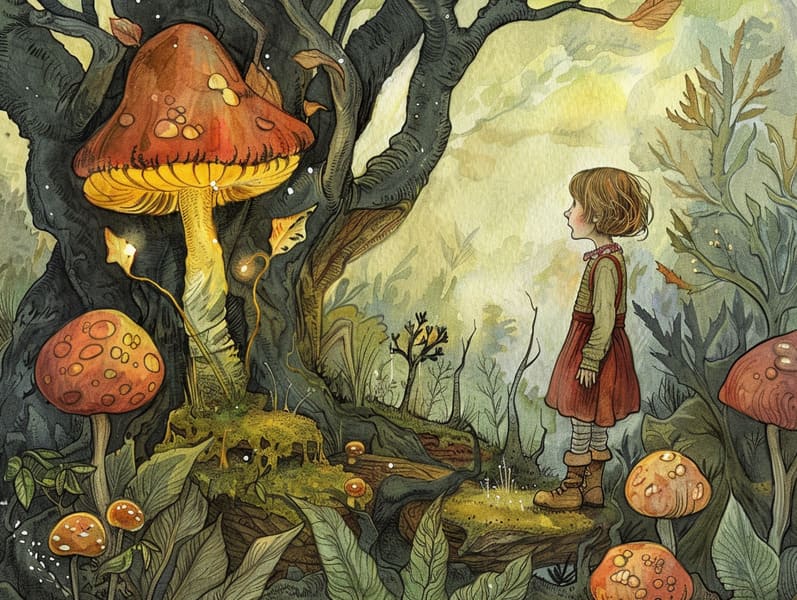
Short fairy tales have long histories. These narratives have been conveyed from one generation to the next centuries before they were ever recorded. They sprang from a variety of societies, including Western traditions. They were initially narrated among adults, often carrying themes and messages relevant to the societal norms and beliefs of the time.
The Brothers Grimm, Jacob and Wilhelm, were among the first to assemble many of these beloved stories. Their volume, "Grimm's Fables," included narratives like "Cinderella," "The Story of Hansel and Gretel," and "The True Story of Snow White," which have since become essentials in the world of children's fairy tales. Similarly, Hans Andersen's fanciful tales, such as "The Mermaid's Tale," and "The Little Duckling," have stolen hearts worldwide, cementing their place in the pantheon of iconic fairy tales.
Despite their historical roots, these tales remain as pertinent as ever, especially as children's bedtime stories. These whimsical stories are now available in multiple formats, including vividly illustrated books, charming animations, and web-based fairy tales.
Their unwavering allure can be connected to several captivating elements:
Significant Morals: Ancient fairy tales often illustrate important moral lessons. Tales like "The Wolf and the Liar" teach the significance of integrity, while "The Hare and the Tortoise" stress the qualities of resolve and unpretentiousness. These tales offer little ones clear distinctions between correct and incorrect, guiding their moral compass in a tender yet impactful way.
Compassion and Knowledge: Timeless fairy tales frequently illustrate heroes facing problems and hurdles, urging young listeners to sympathize with their struggles and applaud their triumphs. For instance, "Beauty's Beast" illustrates the importance of appreciating inner worth to know the inner being of a character, advancing tenderness and discernment.
Cultural Understanding: Many ancient fairy tales are interwoven with the cultural contexts from which they originated. Delving into these fairy tales can provide intriguing perspectives into different traditions, nurturing a sense of world respect and respect.
Imagination and Creativity: The fantastical elements in timeless fairy tales—supernatural elements—activate children’s creativity. These narratives take readers to extraordinary realms, enlivening inventive ideas and a sense of mystery that lasts a lifetime.
Timeless fairy tales are not only whimsical but also pedagogical. They work as alluring tools in check it out cultivating various cognitive and affective skills in children. When ancient fairy tales are spoken out loud, they promote language proficiency by bringing new language items and detailed sentence structures. This practice also advances listening skills and concentration, as young readers focus on every detail, excited to see what happens next.
Furthermore, debating the themes and characters of ancient fairy tales can promote thought processes and analytical skills. Little ones are instructed to discern patterns, predict happenings, and get cause and effect. These conversations also encourage young ones express their thoughts and feelings, boosting their emotional intelligence.
In today’s digital era, the existence of online fairy tales has made these narratives more accessible than ever. Internet sites and web apps offer extensive collections of famous fairy tales that can be browsed or listened to anytime, anywhere. Fairy tales read aloud are particularly favored, making available an fascinating method for young readers to immerse in these fantastical tales. Audiobooks and read-to-me stories guide characters and settings to life, often paired with captivating background sounds and musical scores that enrich the tale-telling adventure.
The lasting allure of classic fairy tales lies in their ability to modify to contemporary times while preserving their essential themes. Contemporary renditions of these stories often feature more inclusive protagonists and modern settings, making them meaningful to today’s audience. However, the core values of daring, charity, and integrity remain unchanged, continuing to strike a chord with kids of all ages.
Fairy tales also offer a sense of serenity and knownness. They render accessible a methodical narrative with a unmistakable beginning, middle, and end, often winding up with the conclusion of conflicts and the triumph of truth over falsehood. This predictability can be relieving for the young, making known a sense of sturdiness in an constantly changing world.
Timeless fairy tales continue to captivate and enlighten new generations, maintaining their delight and relevance in modern society. As children's bedtime stories, they bequeath a perfect blend of fascination and comprehension, developing moral values, empathy, and creativity. The existence of online storybooks and the widespread nature of fairy tales voiced assure that these traditional fairy tales remain within reach to new generations.
By guarding and recounting these narratives, we continue to glorify the rich tapestry of human imagination and cultural heritage. Whether you are perusing a gorgeously illustrated book, discovering a cyber library, or listening on an spoken story, the captivation of timeless fairy tales is always within reach. These fairy tales convey of the lasting spell of fairy tales and its ability to unite us across centuries and lands.
Even if you are accessing a colorful picture book, experiencing a cyber library, or listening through an voice book, the wonder of bedtime fairy tales is always within reach.
These narratives convey of the invariable strength of storytelling and its ability to bring us together across epochs and places, casting a charm that delights and instructs alike.